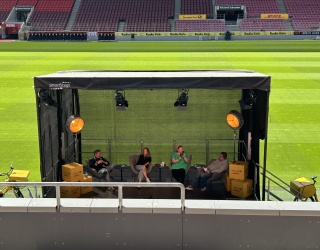The demand for digital marketing strategies that can also be locally applied is growing. Location-based real-time communication enables retailers to bridge the gap between digital advertising and the offline behavior of their customers. That’s why location-based services such as geo-fencing, for instance, hold great potential for digital marketing strategies.
“Geo-fencing is the targeted delivery of advertising material based on the current location of the user,“explains Anke Francovich, Head of Media Consulting at the pilot Agency in Hamburg, Germany. Within a “fenced in“ area, customers receive information and advertising on their smartphone via an app. The location is found via GPS which is able to determine the position of an end device within a radius of ten meters. “GPS enables advertisers to accurately define the locations where advertising material should be delivered. Depending on the size of the area, the accuracy of targeting changes in favor of range. The general rule is, smaller areas result in more relevance of the advertising message to recipients“.
Young, curious and mobile savvy
The majority of users addressed with geo-fencing campaigns are primarily on the go a lot and shopping and mobile savvy. Geo-fencing can be applied to all target groups since GPS data can be combined with specific sociodemographic targeting depending on the provider. “Target audiences can be more effectively targeted this way and waste of resources can be avoided,” adds Francovich.
Once a customer passes through a geo-fence boundary, he/she receives a push notification on the smartphone. Prior to all this, customers need to install the app of the retailer or other shopping app provider on their end device. The notification on the display is similar to a text message or WhatsApp message and therefore catches your eye. “Push notifications achieve open rates between 47 and 80 percent, depending on factors like timing, occasion or relevance,” explains Francovich. Compared to email communication, the rate is considerably higher.
The added benefit of push notifications is clearly rooted in their link to the location. They increase the relevance and draw customers directly into the store. But it’s not just smartphone users who are being considered as a target audience. “Thinking long-term, this channel is also well suited for smartwatches, connected cars and other linked mobile end devices that enable the installation of apps. The increasing relevance of the Internet of Things will potentially also open up new applications and unleash potential“, predicts Francovich.

Push-to-POS
Geo-fencing has one key advantage for retailers: the local brand is strengthened. After all, the primary goal is a “push-to-POS“ – meaning to bring customers into the store – or rather communication at the POS. To accomplish this, coupons with discounts are sent or optionally banners delivered, through which the coupons can be saved as image files. Dynamic distance notifications including maps and route planning functions that lead users directly into the store are also an option.
In collaboration with the location-based services expert Offerista, sporting goods retailer SportScheck has also already implemented several geo-fencing campaigns designed to increase customer footfall in the stores. The campaigns were carried out via the barcoop app which was developed by Offerista. Radius and ad formats are stored in a self-created software that also manages the dispatch of push notifications. In the case of SportScheck, once the software registered that a customer entered past a predefined fence, it automatically sent a coupon valued at ten Euros. This coupon could then be redeemed via a barcode at the stores. Measuring the effectiveness of the campaign can also be done through the system.
Michael Jacobi, Conceptual Design eCommerce and Mobile Apps at SportScheck, explains, “Geo-based push notifications are an attractive way of integrated customer engagement through online and offline channels. The goal was to attract more customers into our stores, to create additional touchpoints and obviously to increase sales during the next step.“
The conversion rate of customers who proved open to mobile marketing was very satisfactory. Jacobi assumes that sales could be further increased with more tests and cases. The next campaign is already waiting in the wings. He points out, “Location-based advertising using geo-fencing campaigns is an inevitable part of the modern marketing mix in the retail sector.”
Geo-fencing is thus generally suited for all retailers who want to have more foot traffic in their stores – regardless of the offered products, size of the product selection and store or number of branches.

Data privacy: more trust equals larger campaigns
Despite the continued debate over data privacy, it’s especially young customers who readily provide data on their current location. According to the “Mobile Behaviour Report“, approximately 71 percent of respondents are willing to provide access to certain apps about their location. Based on a study by Gettings and Goldmedia, 56 percent of German smartphone users already provide access about their location to companies several times per month to benefit from location-based services.
“As a general rule, in order to provide access to their location, users always need to obtain a clear benefit, for instance, receiving information on nearby stores, restaurants and movie theaters as well as a link to coupons or sales,“ explains Francovich. Transparency is key. “Users need to be educated on the pros and cons to promote the acceptance of customized advertising.“
Francovich sums up, “The location-based advertising sector expects a ‘solid‘ growth in spending of 3.3 percent in 2016. For the sector to reach its full potential, however, the key is verification, standardization and anonymization of customer data – this is the only way to make them useful for advertisers.“ Once the worries of users about data protection issues decrease, ranges and subsequently campaign performance will increase.







